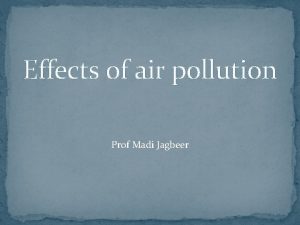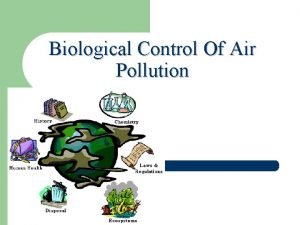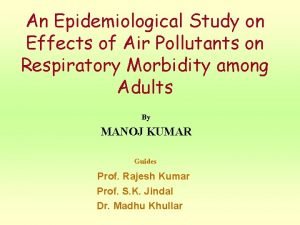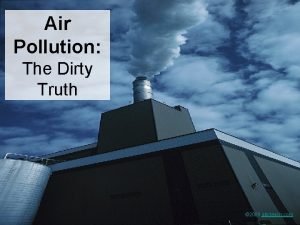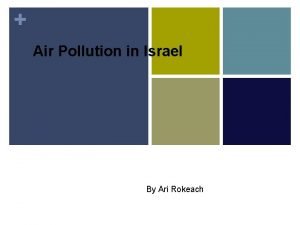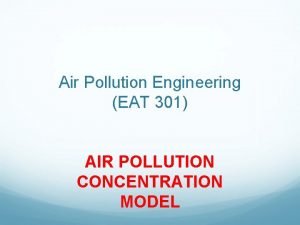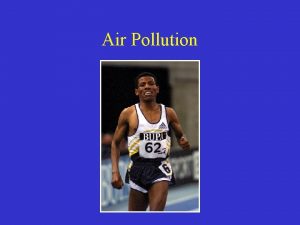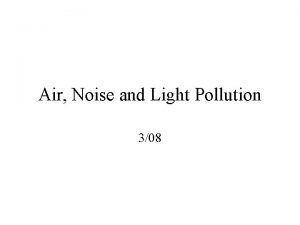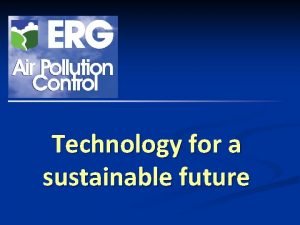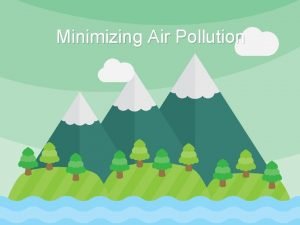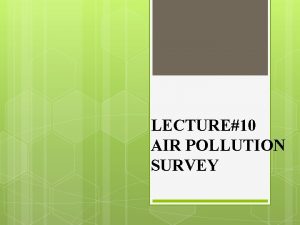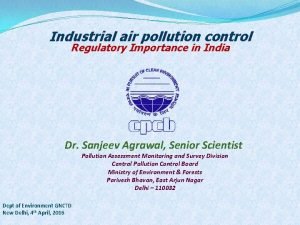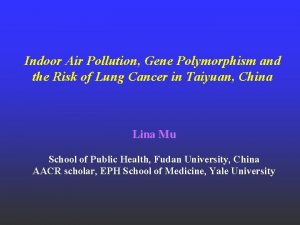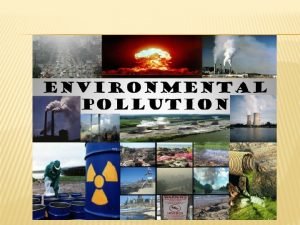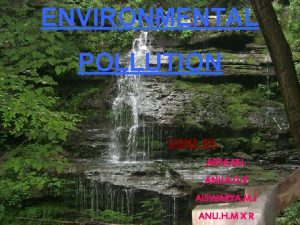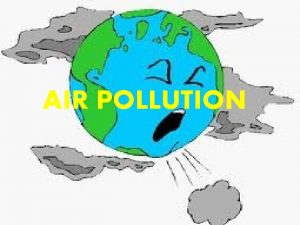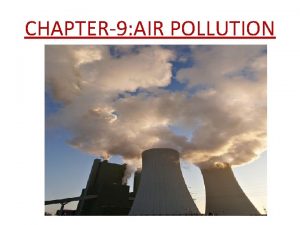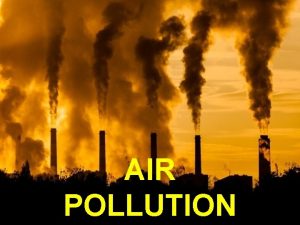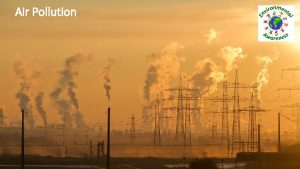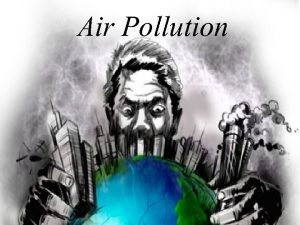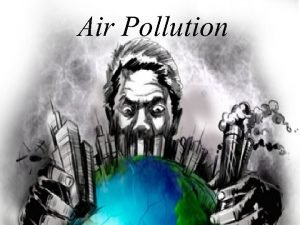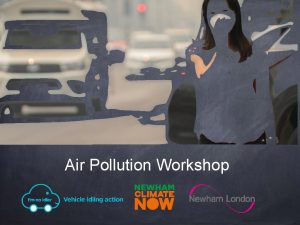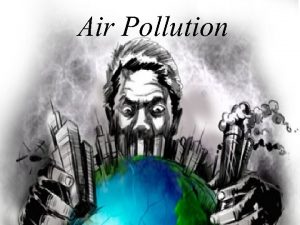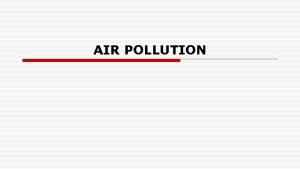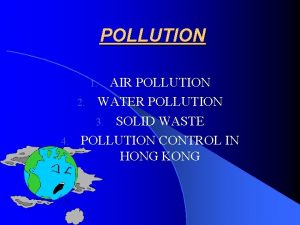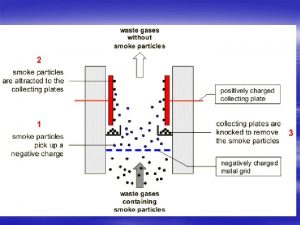Chapter 20 Air Pollution Overview of Chapter 20






















- Slides: 22

Chapter 20 Air Pollution

Overview of Chapter 20 • Atmosphere as a Resource • Types and Sources of Air Pollution • Major Classes of Air Pollutants • Sources of Outdoor Air Pollutants • Urban Air Pollution • Effects of Air Pollution • Controlling Air Pollution in the US

Atmosphere as a Resource • Atmospheric Composition • • Nitrogen 78. 08% Oxygen 20. 95% Argon 0. 93% Carbon dioxide 0. 04% • Ecosystem services • Blocks UV radiation • Moderates the climate • Redistributes water in the hydrologic cycle

Types and Sources of Air Pollution • Chemicals added to the atmosphere by natural events or human activities in high enough concentrations to be harmful • Two categories • Primary Air Pollutant • Harmful substance that is emitted directly into the atmosphere • Secondary Air Pollutant • Harmful substance formed in the atmosphere when a primary air pollutant reacts with substances normally found in the atmosphere or with other air pollutants

Major Air Pollutants


Major Classes of Air Pollutants • Particulate Material • Nitrogen Oxides • Sulfur Oxides • Carbon Oxides • Hydrocarbons • Ozone

Particulate Material • Thousands of different solid or liquid particles suspended in air • Includes: soil particles, soot, lead, asbestos, sea salt, and sulfuric acid droplets • Dangerous for 2 reasons • May contain materials with toxic or carcinogenic effects • Extremely small particles can become lodged in lungs

Nitrogen and Sulfur Oxides • Nitrogen Oxides • Gases produced by the chemical interactions between atmospheric nitrogen and oxygen at high temperature • Problems • Greenhouse gases • Cause difficulty breathing • Sulfur Oxides • Gases produced by the chemical interactions between sulfur and oxygen • Causes acid precipitation

Carbon Oxides and Hydrocarbons • Carbon Oxides • Gases carbon monoxide (CO) and carbon dioxide (CO 2) • Greenhouse gases • Hydrocarbons • Diverse group of organic compounds that contain only hydrogen and carbon (ex: CH 4 - methane) • Some are related to photochemical smog and greenhouse gases

Ozone • Tropospheric Ozone • Man- made pollutant in the lower atmosphere • Secondary air pollutant • Component of photochemical smog • Stratospheric Ozone • Essential component that screens out UV radiation in the upper atmosphere • Man- made pollutants (ex: CFCs) can destroy it

Sources of Outdoor Air Pollution • Two main sources • Transportation • Industry • Intentional forest fires is also high

Urban Air Pollution • Photochemical Smog (ex: Los Angeles below) • Brownish-orange haze formed by chemical reactions involving sunlight, nitrogen oxide, and hydrocarbons

Formation of Photochemical Smog

Sources of Smog in Los Angeles

Effects of Air Pollution • Low level exposure • Irritates eyes • Causes inflammation of respiratory tract • Can develop into chronic respiratory diseases

Health Effects of Air Pollution • Sulfur Dioxide and Particulate material • Irritate respiratory tract and impair ability of lungs to exchange gases • Nitrogen Dioxides • Causes airway restriction • Carbon monoxide • Binds with iron in blood hemoglobin • Causes headache, fatigue, drowsiness, death • Ozone • Causes burning eyes, coughing, and chest discomfort

Children and Air Pollution • Greater health threat to children than adults • Air pollution can restrict lung development • Children breath more often than adults • Children who live in high ozone areas are more likely to develop asthma

The Clean Air Act • Authorizes EPA to set limits on amount of specific air pollutants permitted • Focuses on 6 pollutants: • lead, particulate matter, sulfur dioxide, carbon monoxide, nitrogen oxides, and ozone • Act has led to decreases!

Other Ways to Improve Air Quality • Reduce sulfur content in gasoline from its current average of 330 ppm to 30 ppm • Require federal emission standards for all passenger vehicles • Including SUVs, trucks and minivans • Require emission testing for all vehicles • Including diesel

Air Pollution Around the World • Air quality is deteriorating rapidly in developing countries • Shenyang, China • Residents only see sunlight a few weeks each year • Developing countries have older cars • Still use leaded gasoline • 5 worst cities in world • Beijing, China; Mexico City, Mexico; Shanghai, China; Tehran, Iran; and Calcutta, India

Indoor Air Pollution • Pollutants can be 5100 X greater than outdoors • Most common: • Radon, cigarette smoke, carbon monoxide, nitrogen dioxide, formaldehyde pesticides, lead, cleaning solvents, ozone, and asbestos
 Chapter 12 section 1
Chapter 12 section 1 Chapter 12 air section 1 what causes air pollution
Chapter 12 air section 1 what causes air pollution Hubungan air tanah dan tanaman
Hubungan air tanah dan tanaman Soil pollution effects on human health
Soil pollution effects on human health Controlling measures of noise pollution
Controlling measures of noise pollution Land water and air pollution
Land water and air pollution Introduction of pollution
Introduction of pollution Effect of air pollution to plants
Effect of air pollution to plants Air pollution contents
Air pollution contents Objective of air pollution
Objective of air pollution Main cause of air pollution
Main cause of air pollution Examples of primary pollutants and secondary pollutants
Examples of primary pollutants and secondary pollutants Stationary and mobile sources of air pollution
Stationary and mobile sources of air pollution Air pollution box model example
Air pollution box model example General effects of air pollution
General effects of air pollution Air pollution consequences
Air pollution consequences Erg (air pollution control) ltd
Erg (air pollution control) ltd Air pollution
Air pollution Objectives of air pollution
Objectives of air pollution Pollution control laws in india
Pollution control laws in india Air pollution
Air pollution Air pollution class 9
Air pollution class 9 Aims of pollution
Aims of pollution







